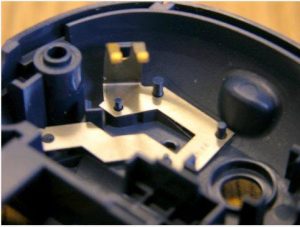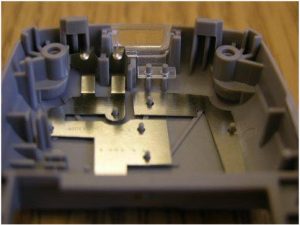Heat Staking of Antennas in Handheld Devices
As the world of electronic components continues to miniaturize, so do the electronic devices that contain them.

Many devices such as cell phones, PDAs, laptops and MP3 players are in great need of real estate within the products’ enclosures to mount critical components and hardware. In the past, locating a one component within 0.01″ of another component was considered close tolerance placement to allow the device to perform correctly. Now, the tolerances have shifted to a degree of 0.005″ and smaller. This creates great challenges to the engineers involved in providing a manufacturing solution.
The performance of components such as an antenna can be greatly improved if their proximity to other live components can be controlled to within .005-.010″. The ability to do so can become expensive and difficult to maintain. If these obstacles can be overcome with proper tooling and equipment, the product’s success and reliability in the marketplace will be realized while profits are retained.
 In the two pictures, before and after examples are shown. A cell phone antenna must be bent to conform to the curved shape of the housing to which they are to be attached. By bending the antenna 0.050″ away from the PCB to be mounted directly above it, the distance between the two increases by almost 100%. This increase in distance is very significant in the performance of the antenna.
In the two pictures, before and after examples are shown. A cell phone antenna must be bent to conform to the curved shape of the housing to which they are to be attached. By bending the antenna 0.050″ away from the PCB to be mounted directly above it, the distance between the two increases by almost 100%. This increase in distance is very significant in the performance of the antenna.
There are two ways to achieve this increase in distance. One way is to pre-bend the antenna from the antenna supplier. This is rather expensive and requires special packaging to eliminate damage during packaging and shipping. The other way is to invest in quality tooling and equipment to perform the bending during the assembly process. This investment is quickly realized in greater yields and savings of raw components. Thermal Press International prides itself on making machines that can provide the accuracy and repeatability necessary to perform such precise heat staking requirements enabling the manufacturer to realize these savings.
In both of the examples shown, the manufacturers were able to purchase antennas at the lowest price available with shortest lead times. In both cases the antennas are flat, and the bending process is left to the tooling and the heat staking equipment.
By working with Thermal Press engineers in the development stage, we were able to calculate the degree of bending required and incorporate this into the heat stake tool as a feature. This is now considered standard protocol for designing products in this category.
Contact Us or call (925) 454-9800 to speak with a Thermal Press engineer.